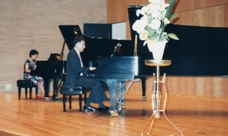
Fingernails have to be trimmed. Correct technique requires that the fingers be curved when playing the piano. Long fingernails make correct technique impossible.
Technique is of the utmost importance. Make a commitment to develop correct technique through practice. Playing an instrument is a physical activity. Your body and muscles must be trained, and correct form and technique will give the best results.
Daily practice is more effective than sporadic, occasional practice. Aim to practice at the same time everyday.
Have a goal in mind when you sit down to practice, and work towards that goal. The goal might be something like "be able to play the first line smoothly" or "be able to play through my problem spot" or "be able play this exercise a little faster" and so on.
Keep a "can do" attitude. If you don't seem to be doing particularly well, move on to something else and come back to that piece of music later in the practice session or the next day. Playing music requires much concentration; if you're "tired", then work on something a little less challenging such as an easier piece or technique exercises. Remember, YOU CAN DO IT ... with practice.
Hey, didn't you hire your instructor to instruct you or your child? Follow his or her guidance for best results. Some tweaking is allowed, so long as the "essence" or the purpose is attained. For instance, if instructed to "practice 5 times daily," you are welcome to practice it more than 5 times. Or if instructed to "practice the first page," you are welcome to practice past the first page IF you have SUCCESSFULLY MASTERED ALL ASPECTS required on the first page.
You will be given this advice by every instructor you meet. Achieve correct technique, notes, and rhythm and a smooth flow (and for the more advanced--phrasing) before you attempt speed.
Technic exercises are usually repeating patterns that once learned, should not require you to read the music. For beginners ONLY: play the pattern as you LOOK AT YOUR FINGERS and make sure that your fingers are curved! With practice, curved fingers and "quiet" hands will be natural and will no longer require this sort of conscious effort.
Beginners, keep your eyes on the music, not your fingers. Beginner pieces do not require you to reposition your hands once you've placed them on the keyboard. Keep your hands positioned, and learn to coordinate your fingers with the written music without looking at your hands. Resist the urge! This is eye-hands-and-fingers coordination for music.